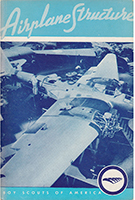Pamphlet Used to Earn this Badge
Requirements Aprip 1942 until 1947
- Identify on a sketch, a model or a plane, the major parts of an airplane and explain the purpose of each:
Fuselage—cabin, cockpit.
Landing gear—struts, wheels, wheel pants, brakes.
Engine—cowling, spinner, propeller.
Wings—leading and trailing edges, ailerons, flaps, slots.
Empennage—fin, rudder, tabs, elevator, stabilizer
- Identify, in the fewest possible words, an airplane from its three standard silhouettes, or as seen in flight 7
- Show by sketch or small model how light weight reinforcement is used in wing, and body or tail assembly
- Explain with rough diagrams the rigging of a plane to secure symmetry and balance
- Demonstrate with sketches, or simple working model (not part of model airplane), the operation of the control system—stick or wheel—pedals—rudder—ailerons—elevator. If satisfactory open working model is made, that may be substituted for Requirement No. 8 belowuild a rubber
- Build a rubber-band powered flying model airplane having built-up fuselage and cambered wings (at least one surface). (Kit may be used.)
- Reduce this flying model (No. 6 above or No. 9 below) to a fairly accurate scale drawing, showing three projections - lateral, front, and horizontal.
- Carve a balanced single-blade propeller and fly
the above model with it, reporting relative effectiveness; OR make a free-wheeling propeller at- tachment for one of these model planes; OR make a scale shelf model of a plane. (Kit may be used.)
- Build a simple triangular kite to ascend vertically, using a rubber band powered propeller.
- Fly the model made in requirement No. 6, in com- petition with at least two models




